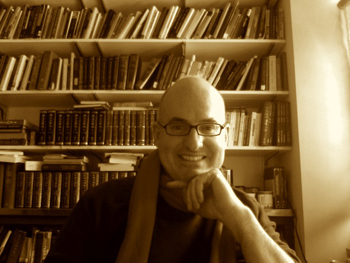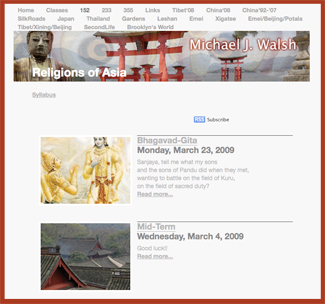RELI 152 & 235
 Taught by: Michael Walsh
Taught by: Michael Walsh
The Course
What is the course in which you use instructional technologies about? Tell us about its origin, goals and objectives.
I use instructional technologies in most of my courses — Religions of Asia, Buddhist Cultures, Religion in China, and so forth — such as my own website, Moodle, QTVR, Google Earth, etc. I am currently building a database of all the photos I have taken throughout Asia, as well as video footage. This becomes a pedagogical challenge to present in the classroom. I love material culture so I want my students to see and hear as much as possible about the culture I am teaching about. Most of my classes look at everyday cultural practices throughout East Asia and specifically China, so any images I have are extremely useful to my teaching. Using my own Flip video camera, and a Nikon D40 SLR camera purchased with Frances T. Fergusson Technology Exploration funds, I recently documented a trip to China and Tibet this past summer.
The Technology
 What were the technologies used and how did they change or enhance your course?
What were the technologies used and how did they change or enhance your course?
This past fall, and currently this semester (S ’09), I am using video footage and images from the China/Tibet trip in two of my classes, Religions of Asia and Buddhist Cultures. Along with images and video footage I can then explore, using iWeb, iMovie, Google Earth and Maps, the sites where the images and footage were taken; the idea being to get as “close to the ground” as possible.
The Student Response
How have your students responded to your use of this technology?
In general, students respond well to any multimedia experience. In my case the feedback continues to be positive. The images always prompt much classroom discussion.
The Challenges
What are the challenges you faced teaching this course?
The challenge continues to be how to use images and other multimedia in a pedagogically productive way so that both my students and I feel we are getting as much as we can from the materials. This is difficult. It’s easy for me to show a picture of a Buddhist temple and have students say, “Wow, that’s beautiful.” The challenge is to make use of the image to talk about lifestyle, architecture, space, and symbolism in a way that allows for the image to be a viewfinder into a much larger reality.
New Directions
What new directions would you like to explore with technology in your teaching?
I want to finish my photo archive as soon as possible, which means working with Aperture, Luna Insight, and FileMaker Pro. Sarah Goldstein has been helping me in this regard. It takes a lot of time — I need to input metadata for each image. Then there is the challenge of exporting the images and metadata in such a manner that they can be uploaded into Luna.
